Comprehensive Data Management and Business Intelligence Report: UE
VerifiedAdded on 2020/03/16
|12
|2951
|35
Report
AI Summary
This report examines the data management and business intelligence strategies employed by United Energy Distribution Pty for its smart meter project. It begins with an introduction to the company and its operations, including critical data, key stakeholders, and financial performance. The report then delves into the communication networks and data systems required for the smart meter project, including the coordination of mobile networks and internal data processing. A significant portion of the report is dedicated to the critique and justification of the database management system selected for the project, along with a review of existing systems and the implications of new technology. The study also covers IT and data governance systems, providing a comprehensive overview of the project's data-related aspects. The report highlights the importance of data management in the success of the smart meter project, emphasizing the need for robust systems and careful consideration of data security and integration with legacy systems. It concludes with a summary of the findings and a reference list.
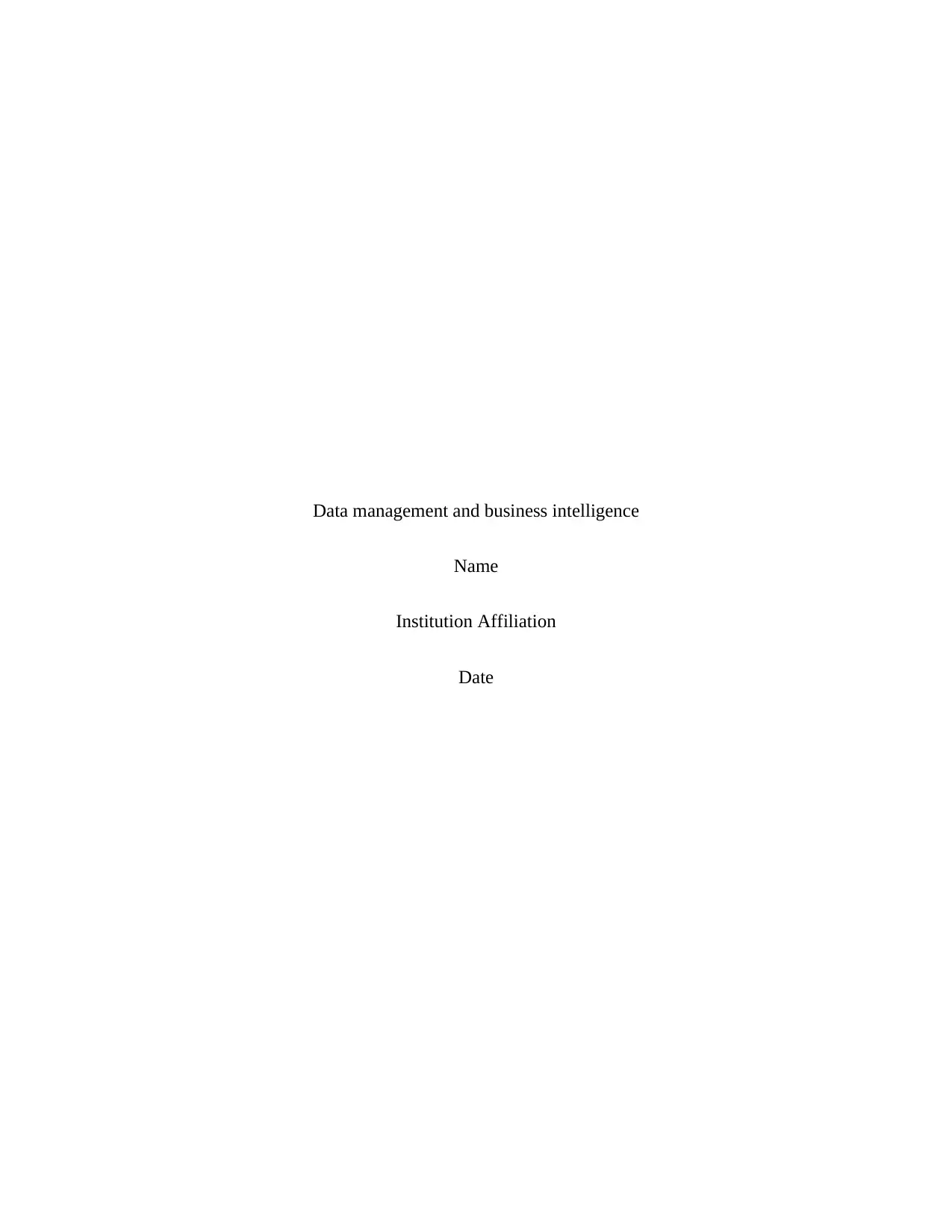
Data management and business intelligence
Name
Institution Affiliation
Date
Name
Institution Affiliation
Date
Secure Best Marks with AI Grader
Need help grading? Try our AI Grader for instant feedback on your assignments.
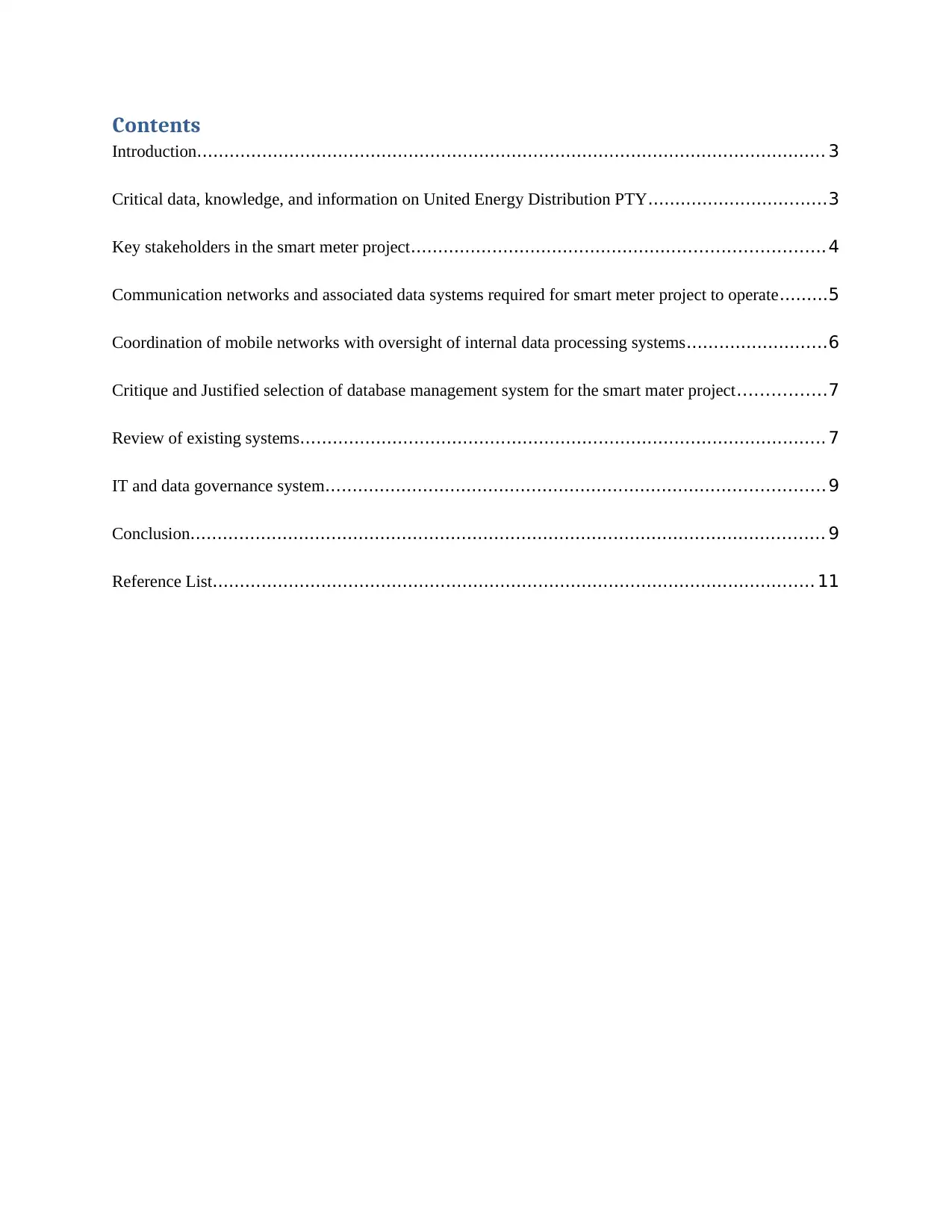
Contents
Introduction.................................................................................................................... 3
Critical data, knowledge, and information on United Energy Distribution PTY.................................3
Key stakeholders in the smart meter project............................................................................4
Communication networks and associated data systems required for smart meter project to operate.........5
Coordination of mobile networks with oversight of internal data processing systems..........................6
Critique and Justified selection of database management system for the smart mater project................7
Review of existing systems................................................................................................. 7
IT and data governance system............................................................................................ 9
Conclusion..................................................................................................................... 9
Reference List............................................................................................................... 11
Introduction.................................................................................................................... 3
Critical data, knowledge, and information on United Energy Distribution PTY.................................3
Key stakeholders in the smart meter project............................................................................4
Communication networks and associated data systems required for smart meter project to operate.........5
Coordination of mobile networks with oversight of internal data processing systems..........................6
Critique and Justified selection of database management system for the smart mater project................7
Review of existing systems................................................................................................. 7
IT and data governance system............................................................................................ 9
Conclusion..................................................................................................................... 9
Reference List............................................................................................................... 11
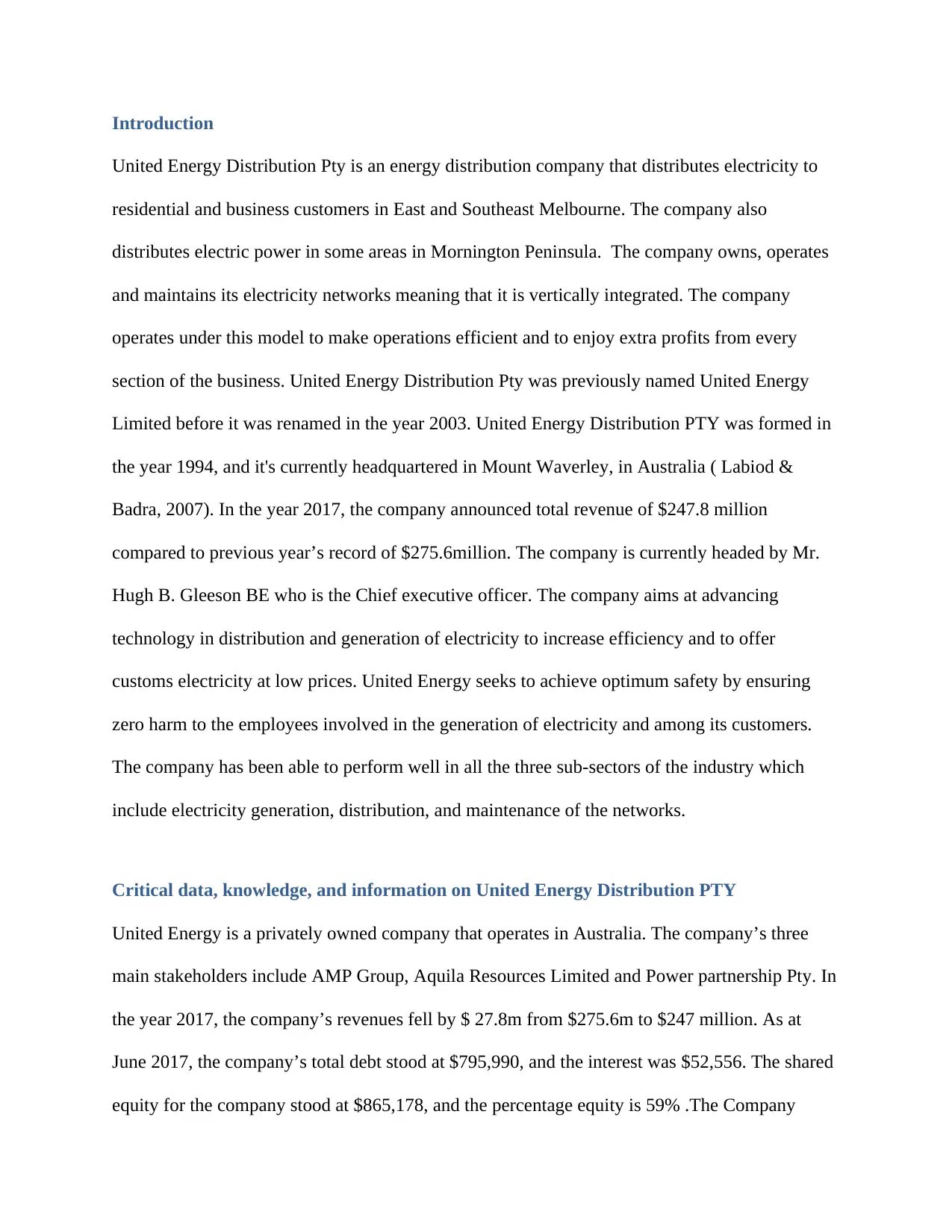
Introduction
United Energy Distribution Pty is an energy distribution company that distributes electricity to
residential and business customers in East and Southeast Melbourne. The company also
distributes electric power in some areas in Mornington Peninsula. The company owns, operates
and maintains its electricity networks meaning that it is vertically integrated. The company
operates under this model to make operations efficient and to enjoy extra profits from every
section of the business. United Energy Distribution Pty was previously named United Energy
Limited before it was renamed in the year 2003. United Energy Distribution PTY was formed in
the year 1994, and it's currently headquartered in Mount Waverley, in Australia ( Labiod &
Badra, 2007). In the year 2017, the company announced total revenue of $247.8 million
compared to previous year’s record of $275.6million. The company is currently headed by Mr.
Hugh B. Gleeson BE who is the Chief executive officer. The company aims at advancing
technology in distribution and generation of electricity to increase efficiency and to offer
customs electricity at low prices. United Energy seeks to achieve optimum safety by ensuring
zero harm to the employees involved in the generation of electricity and among its customers.
The company has been able to perform well in all the three sub-sectors of the industry which
include electricity generation, distribution, and maintenance of the networks.
Critical data, knowledge, and information on United Energy Distribution PTY
United Energy is a privately owned company that operates in Australia. The company’s three
main stakeholders include AMP Group, Aquila Resources Limited and Power partnership Pty. In
the year 2017, the company’s revenues fell by $ 27.8m from $275.6m to $247 million. As at
June 2017, the company’s total debt stood at $795,990, and the interest was $52,556. The shared
equity for the company stood at $865,178, and the percentage equity is 59% .The Company
United Energy Distribution Pty is an energy distribution company that distributes electricity to
residential and business customers in East and Southeast Melbourne. The company also
distributes electric power in some areas in Mornington Peninsula. The company owns, operates
and maintains its electricity networks meaning that it is vertically integrated. The company
operates under this model to make operations efficient and to enjoy extra profits from every
section of the business. United Energy Distribution Pty was previously named United Energy
Limited before it was renamed in the year 2003. United Energy Distribution PTY was formed in
the year 1994, and it's currently headquartered in Mount Waverley, in Australia ( Labiod &
Badra, 2007). In the year 2017, the company announced total revenue of $247.8 million
compared to previous year’s record of $275.6million. The company is currently headed by Mr.
Hugh B. Gleeson BE who is the Chief executive officer. The company aims at advancing
technology in distribution and generation of electricity to increase efficiency and to offer
customs electricity at low prices. United Energy seeks to achieve optimum safety by ensuring
zero harm to the employees involved in the generation of electricity and among its customers.
The company has been able to perform well in all the three sub-sectors of the industry which
include electricity generation, distribution, and maintenance of the networks.
Critical data, knowledge, and information on United Energy Distribution PTY
United Energy is a privately owned company that operates in Australia. The company’s three
main stakeholders include AMP Group, Aquila Resources Limited and Power partnership Pty. In
the year 2017, the company’s revenues fell by $ 27.8m from $275.6m to $247 million. As at
June 2017, the company’s total debt stood at $795,990, and the interest was $52,556. The shared
equity for the company stood at $865,178, and the percentage equity is 59% .The Company
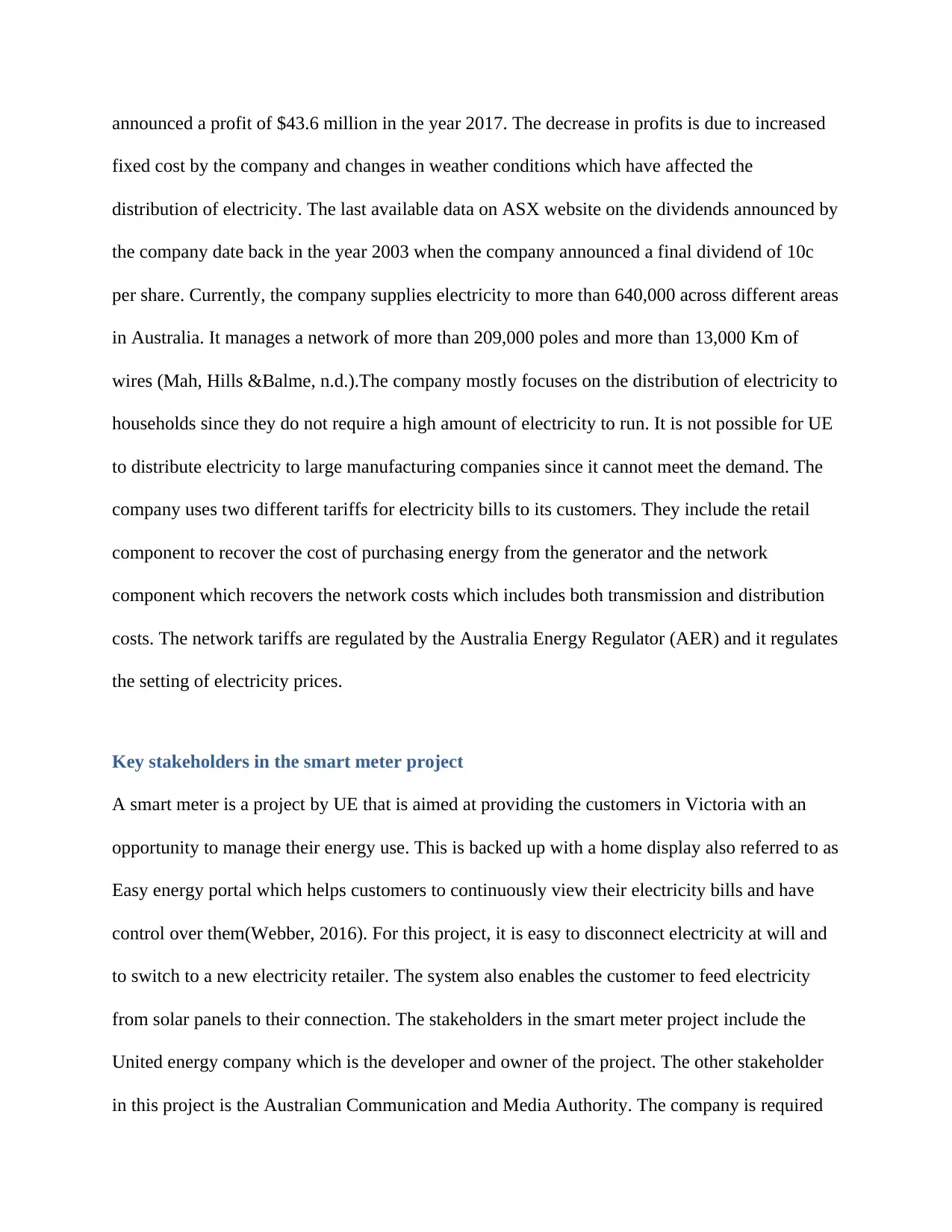
announced a profit of $43.6 million in the year 2017. The decrease in profits is due to increased
fixed cost by the company and changes in weather conditions which have affected the
distribution of electricity. The last available data on ASX website on the dividends announced by
the company date back in the year 2003 when the company announced a final dividend of 10c
per share. Currently, the company supplies electricity to more than 640,000 across different areas
in Australia. It manages a network of more than 209,000 poles and more than 13,000 Km of
wires (Mah, Hills &Balme, n.d.).The company mostly focuses on the distribution of electricity to
households since they do not require a high amount of electricity to run. It is not possible for UE
to distribute electricity to large manufacturing companies since it cannot meet the demand. The
company uses two different tariffs for electricity bills to its customers. They include the retail
component to recover the cost of purchasing energy from the generator and the network
component which recovers the network costs which includes both transmission and distribution
costs. The network tariffs are regulated by the Australia Energy Regulator (AER) and it regulates
the setting of electricity prices.
Key stakeholders in the smart meter project
A smart meter is a project by UE that is aimed at providing the customers in Victoria with an
opportunity to manage their energy use. This is backed up with a home display also referred to as
Easy energy portal which helps customers to continuously view their electricity bills and have
control over them(Webber, 2016). For this project, it is easy to disconnect electricity at will and
to switch to a new electricity retailer. The system also enables the customer to feed electricity
from solar panels to their connection. The stakeholders in the smart meter project include the
United energy company which is the developer and owner of the project. The other stakeholder
in this project is the Australian Communication and Media Authority. The company is required
fixed cost by the company and changes in weather conditions which have affected the
distribution of electricity. The last available data on ASX website on the dividends announced by
the company date back in the year 2003 when the company announced a final dividend of 10c
per share. Currently, the company supplies electricity to more than 640,000 across different areas
in Australia. It manages a network of more than 209,000 poles and more than 13,000 Km of
wires (Mah, Hills &Balme, n.d.).The company mostly focuses on the distribution of electricity to
households since they do not require a high amount of electricity to run. It is not possible for UE
to distribute electricity to large manufacturing companies since it cannot meet the demand. The
company uses two different tariffs for electricity bills to its customers. They include the retail
component to recover the cost of purchasing energy from the generator and the network
component which recovers the network costs which includes both transmission and distribution
costs. The network tariffs are regulated by the Australia Energy Regulator (AER) and it regulates
the setting of electricity prices.
Key stakeholders in the smart meter project
A smart meter is a project by UE that is aimed at providing the customers in Victoria with an
opportunity to manage their energy use. This is backed up with a home display also referred to as
Easy energy portal which helps customers to continuously view their electricity bills and have
control over them(Webber, 2016). For this project, it is easy to disconnect electricity at will and
to switch to a new electricity retailer. The system also enables the customer to feed electricity
from solar panels to their connection. The stakeholders in the smart meter project include the
United energy company which is the developer and owner of the project. The other stakeholder
in this project is the Australian Communication and Media Authority. The company is required
Secure Best Marks with AI Grader
Need help grading? Try our AI Grader for instant feedback on your assignments.
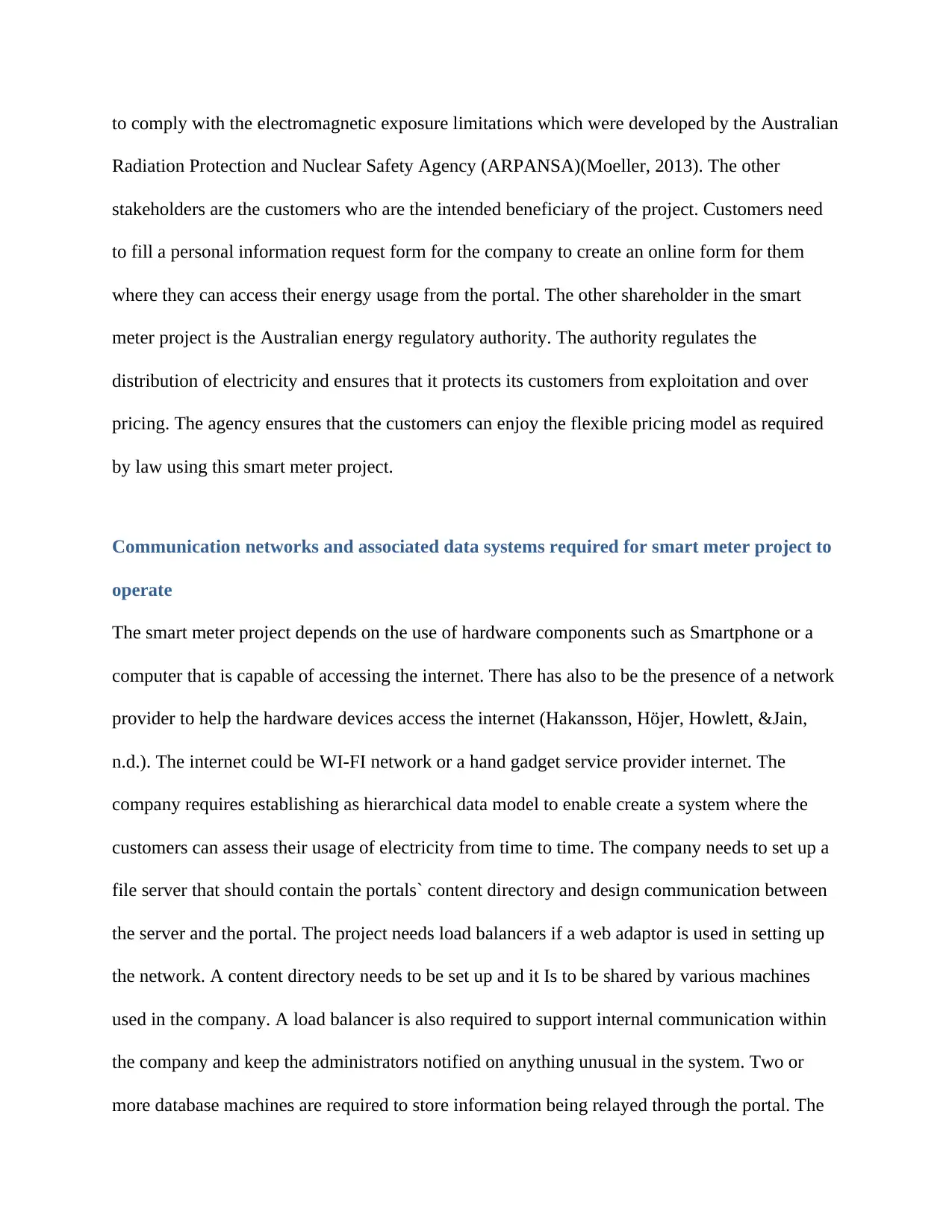
to comply with the electromagnetic exposure limitations which were developed by the Australian
Radiation Protection and Nuclear Safety Agency (ARPANSA)(Moeller, 2013). The other
stakeholders are the customers who are the intended beneficiary of the project. Customers need
to fill a personal information request form for the company to create an online form for them
where they can access their energy usage from the portal. The other shareholder in the smart
meter project is the Australian energy regulatory authority. The authority regulates the
distribution of electricity and ensures that it protects its customers from exploitation and over
pricing. The agency ensures that the customers can enjoy the flexible pricing model as required
by law using this smart meter project.
Communication networks and associated data systems required for smart meter project to
operate
The smart meter project depends on the use of hardware components such as Smartphone or a
computer that is capable of accessing the internet. There has also to be the presence of a network
provider to help the hardware devices access the internet (Hakansson, Höjer, Howlett, &Jain,
n.d.). The internet could be WI-FI network or a hand gadget service provider internet. The
company requires establishing as hierarchical data model to enable create a system where the
customers can assess their usage of electricity from time to time. The company needs to set up a
file server that should contain the portals` content directory and design communication between
the server and the portal. The project needs load balancers if a web adaptor is used in setting up
the network. A content directory needs to be set up and it Is to be shared by various machines
used in the company. A load balancer is also required to support internal communication within
the company and keep the administrators notified on anything unusual in the system. Two or
more database machines are required to store information being relayed through the portal. The
Radiation Protection and Nuclear Safety Agency (ARPANSA)(Moeller, 2013). The other
stakeholders are the customers who are the intended beneficiary of the project. Customers need
to fill a personal information request form for the company to create an online form for them
where they can access their energy usage from the portal. The other shareholder in the smart
meter project is the Australian energy regulatory authority. The authority regulates the
distribution of electricity and ensures that it protects its customers from exploitation and over
pricing. The agency ensures that the customers can enjoy the flexible pricing model as required
by law using this smart meter project.
Communication networks and associated data systems required for smart meter project to
operate
The smart meter project depends on the use of hardware components such as Smartphone or a
computer that is capable of accessing the internet. There has also to be the presence of a network
provider to help the hardware devices access the internet (Hakansson, Höjer, Howlett, &Jain,
n.d.). The internet could be WI-FI network or a hand gadget service provider internet. The
company requires establishing as hierarchical data model to enable create a system where the
customers can assess their usage of electricity from time to time. The company needs to set up a
file server that should contain the portals` content directory and design communication between
the server and the portal. The project needs load balancers if a web adaptor is used in setting up
the network. A content directory needs to be set up and it Is to be shared by various machines
used in the company. A load balancer is also required to support internal communication within
the company and keep the administrators notified on anything unusual in the system. Two or
more database machines are required to store information being relayed through the portal. The
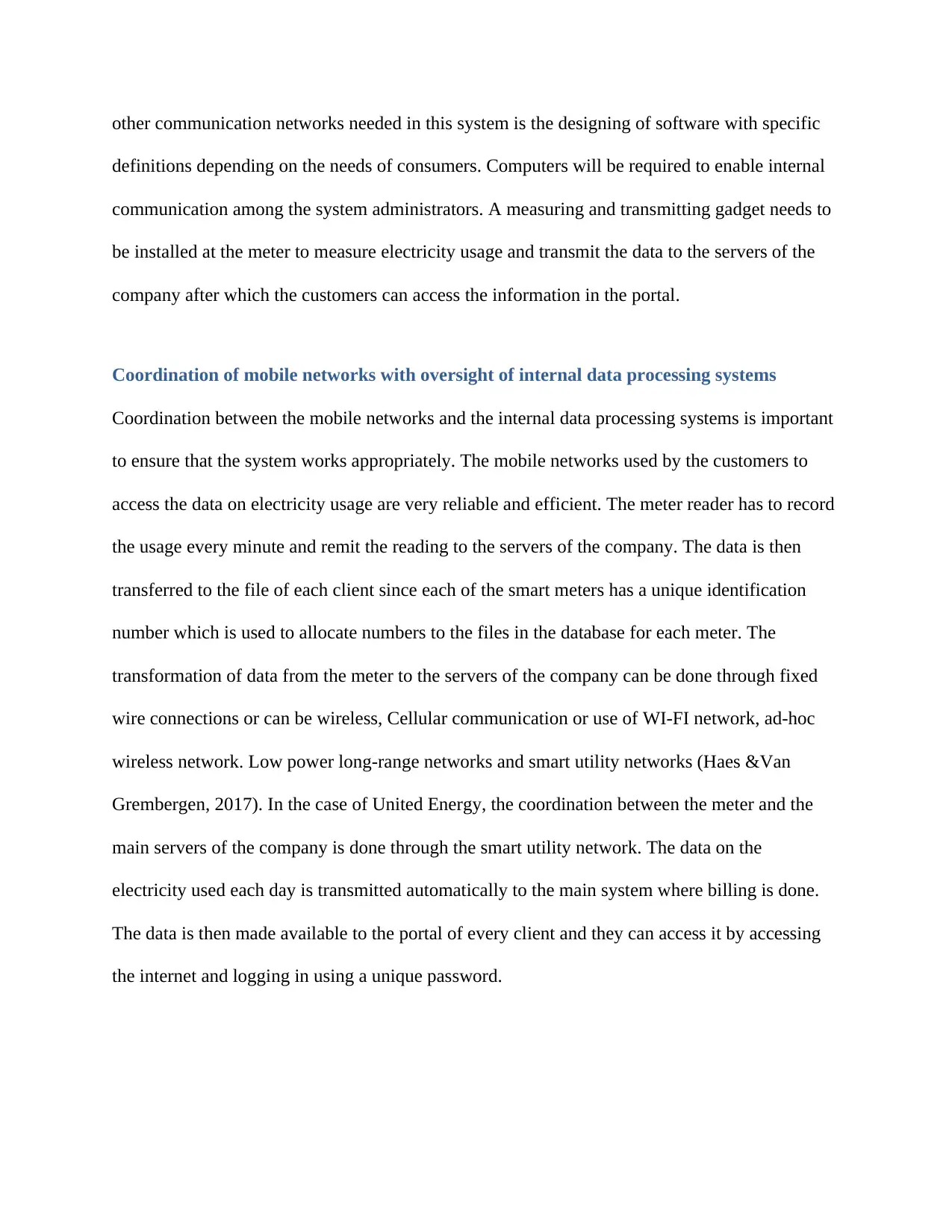
other communication networks needed in this system is the designing of software with specific
definitions depending on the needs of consumers. Computers will be required to enable internal
communication among the system administrators. A measuring and transmitting gadget needs to
be installed at the meter to measure electricity usage and transmit the data to the servers of the
company after which the customers can access the information in the portal.
Coordination of mobile networks with oversight of internal data processing systems
Coordination between the mobile networks and the internal data processing systems is important
to ensure that the system works appropriately. The mobile networks used by the customers to
access the data on electricity usage are very reliable and efficient. The meter reader has to record
the usage every minute and remit the reading to the servers of the company. The data is then
transferred to the file of each client since each of the smart meters has a unique identification
number which is used to allocate numbers to the files in the database for each meter. The
transformation of data from the meter to the servers of the company can be done through fixed
wire connections or can be wireless, Cellular communication or use of WI-FI network, ad-hoc
wireless network. Low power long-range networks and smart utility networks (Haes &Van
Grembergen, 2017). In the case of United Energy, the coordination between the meter and the
main servers of the company is done through the smart utility network. The data on the
electricity used each day is transmitted automatically to the main system where billing is done.
The data is then made available to the portal of every client and they can access it by accessing
the internet and logging in using a unique password.
definitions depending on the needs of consumers. Computers will be required to enable internal
communication among the system administrators. A measuring and transmitting gadget needs to
be installed at the meter to measure electricity usage and transmit the data to the servers of the
company after which the customers can access the information in the portal.
Coordination of mobile networks with oversight of internal data processing systems
Coordination between the mobile networks and the internal data processing systems is important
to ensure that the system works appropriately. The mobile networks used by the customers to
access the data on electricity usage are very reliable and efficient. The meter reader has to record
the usage every minute and remit the reading to the servers of the company. The data is then
transferred to the file of each client since each of the smart meters has a unique identification
number which is used to allocate numbers to the files in the database for each meter. The
transformation of data from the meter to the servers of the company can be done through fixed
wire connections or can be wireless, Cellular communication or use of WI-FI network, ad-hoc
wireless network. Low power long-range networks and smart utility networks (Haes &Van
Grembergen, 2017). In the case of United Energy, the coordination between the meter and the
main servers of the company is done through the smart utility network. The data on the
electricity used each day is transmitted automatically to the main system where billing is done.
The data is then made available to the portal of every client and they can access it by accessing
the internet and logging in using a unique password.
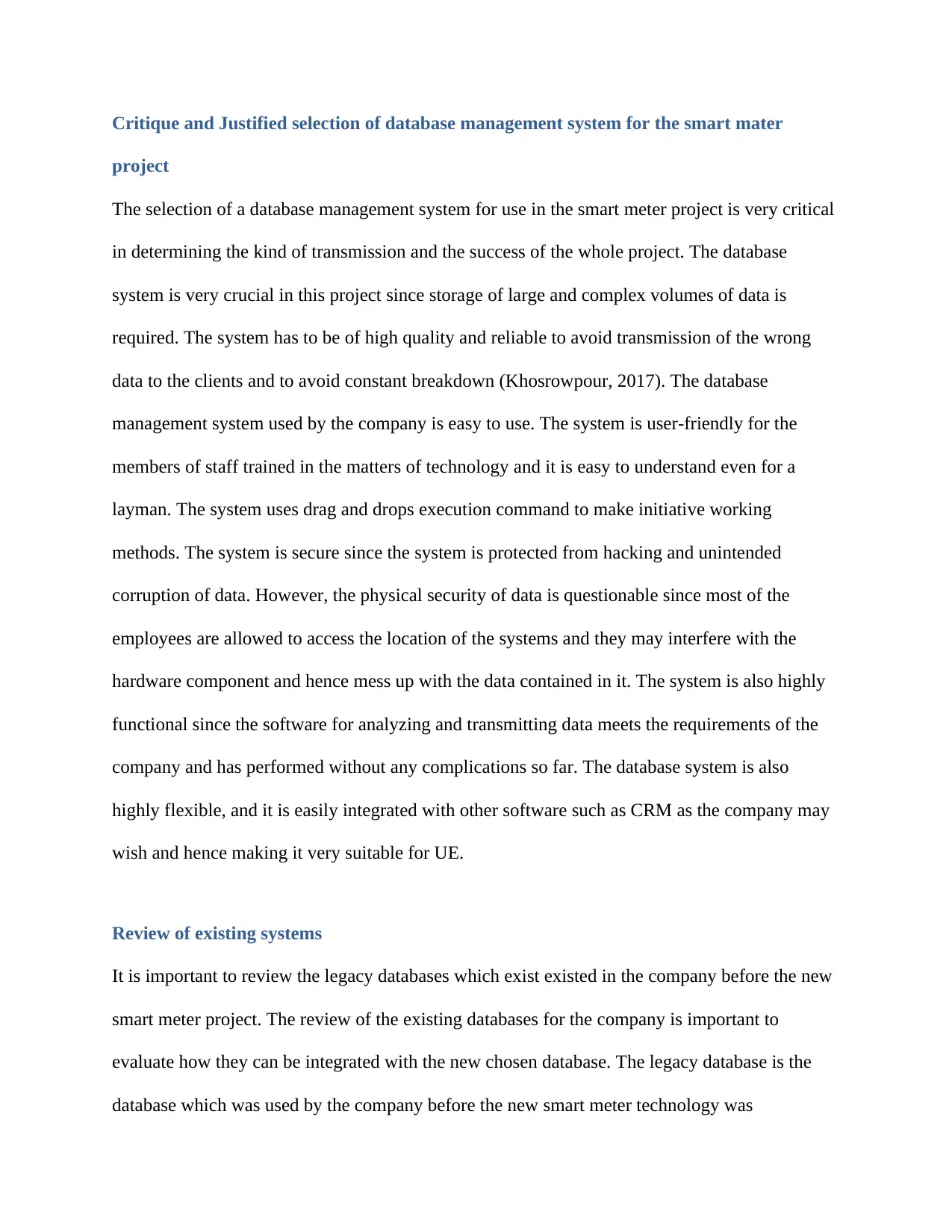
Critique and Justified selection of database management system for the smart mater
project
The selection of a database management system for use in the smart meter project is very critical
in determining the kind of transmission and the success of the whole project. The database
system is very crucial in this project since storage of large and complex volumes of data is
required. The system has to be of high quality and reliable to avoid transmission of the wrong
data to the clients and to avoid constant breakdown (Khosrowpour, 2017). The database
management system used by the company is easy to use. The system is user-friendly for the
members of staff trained in the matters of technology and it is easy to understand even for a
layman. The system uses drag and drops execution command to make initiative working
methods. The system is secure since the system is protected from hacking and unintended
corruption of data. However, the physical security of data is questionable since most of the
employees are allowed to access the location of the systems and they may interfere with the
hardware component and hence mess up with the data contained in it. The system is also highly
functional since the software for analyzing and transmitting data meets the requirements of the
company and has performed without any complications so far. The database system is also
highly flexible, and it is easily integrated with other software such as CRM as the company may
wish and hence making it very suitable for UE.
Review of existing systems
It is important to review the legacy databases which exist existed in the company before the new
smart meter project. The review of the existing databases for the company is important to
evaluate how they can be integrated with the new chosen database. The legacy database is the
database which was used by the company before the new smart meter technology was
project
The selection of a database management system for use in the smart meter project is very critical
in determining the kind of transmission and the success of the whole project. The database
system is very crucial in this project since storage of large and complex volumes of data is
required. The system has to be of high quality and reliable to avoid transmission of the wrong
data to the clients and to avoid constant breakdown (Khosrowpour, 2017). The database
management system used by the company is easy to use. The system is user-friendly for the
members of staff trained in the matters of technology and it is easy to understand even for a
layman. The system uses drag and drops execution command to make initiative working
methods. The system is secure since the system is protected from hacking and unintended
corruption of data. However, the physical security of data is questionable since most of the
employees are allowed to access the location of the systems and they may interfere with the
hardware component and hence mess up with the data contained in it. The system is also highly
functional since the software for analyzing and transmitting data meets the requirements of the
company and has performed without any complications so far. The database system is also
highly flexible, and it is easily integrated with other software such as CRM as the company may
wish and hence making it very suitable for UE.
Review of existing systems
It is important to review the legacy databases which exist existed in the company before the new
smart meter project. The review of the existing databases for the company is important to
evaluate how they can be integrated with the new chosen database. The legacy database is the
database which was used by the company before the new smart meter technology was
Paraphrase This Document
Need a fresh take? Get an instant paraphrase of this document with our AI Paraphraser
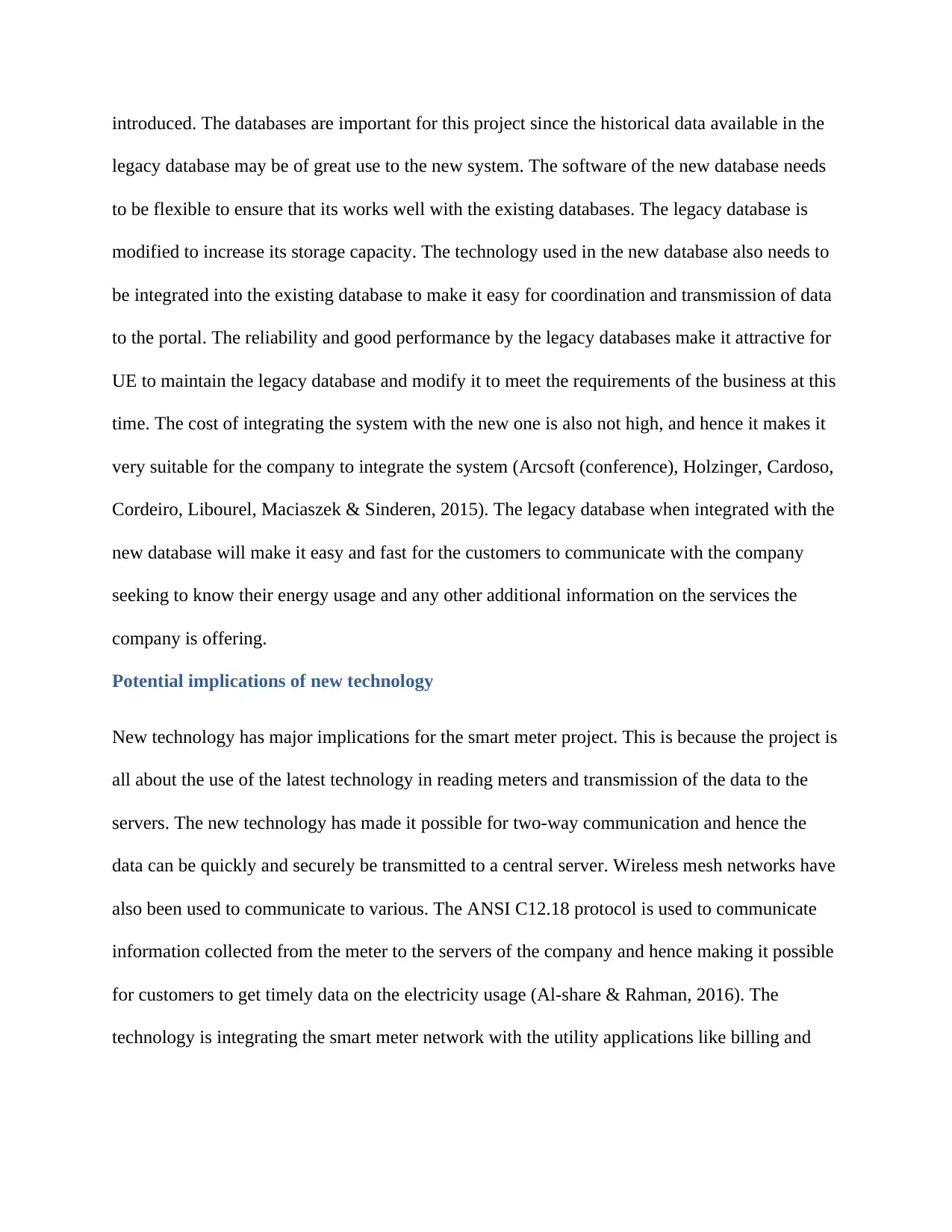
introduced. The databases are important for this project since the historical data available in the
legacy database may be of great use to the new system. The software of the new database needs
to be flexible to ensure that its works well with the existing databases. The legacy database is
modified to increase its storage capacity. The technology used in the new database also needs to
be integrated into the existing database to make it easy for coordination and transmission of data
to the portal. The reliability and good performance by the legacy databases make it attractive for
UE to maintain the legacy database and modify it to meet the requirements of the business at this
time. The cost of integrating the system with the new one is also not high, and hence it makes it
very suitable for the company to integrate the system (Arcsoft (conference), Holzinger, Cardoso,
Cordeiro, Libourel, Maciaszek & Sinderen, 2015). The legacy database when integrated with the
new database will make it easy and fast for the customers to communicate with the company
seeking to know their energy usage and any other additional information on the services the
company is offering.
Potential implications of new technology
New technology has major implications for the smart meter project. This is because the project is
all about the use of the latest technology in reading meters and transmission of the data to the
servers. The new technology has made it possible for two-way communication and hence the
data can be quickly and securely be transmitted to a central server. Wireless mesh networks have
also been used to communicate to various. The ANSI C12.18 protocol is used to communicate
information collected from the meter to the servers of the company and hence making it possible
for customers to get timely data on the electricity usage (Al-share & Rahman, 2016). The
technology is integrating the smart meter network with the utility applications like billing and
legacy database may be of great use to the new system. The software of the new database needs
to be flexible to ensure that its works well with the existing databases. The legacy database is
modified to increase its storage capacity. The technology used in the new database also needs to
be integrated into the existing database to make it easy for coordination and transmission of data
to the portal. The reliability and good performance by the legacy databases make it attractive for
UE to maintain the legacy database and modify it to meet the requirements of the business at this
time. The cost of integrating the system with the new one is also not high, and hence it makes it
very suitable for the company to integrate the system (Arcsoft (conference), Holzinger, Cardoso,
Cordeiro, Libourel, Maciaszek & Sinderen, 2015). The legacy database when integrated with the
new database will make it easy and fast for the customers to communicate with the company
seeking to know their energy usage and any other additional information on the services the
company is offering.
Potential implications of new technology
New technology has major implications for the smart meter project. This is because the project is
all about the use of the latest technology in reading meters and transmission of the data to the
servers. The new technology has made it possible for two-way communication and hence the
data can be quickly and securely be transmitted to a central server. Wireless mesh networks have
also been used to communicate to various. The ANSI C12.18 protocol is used to communicate
information collected from the meter to the servers of the company and hence making it possible
for customers to get timely data on the electricity usage (Al-share & Rahman, 2016). The
technology is integrating the smart meter network with the utility applications like billing and
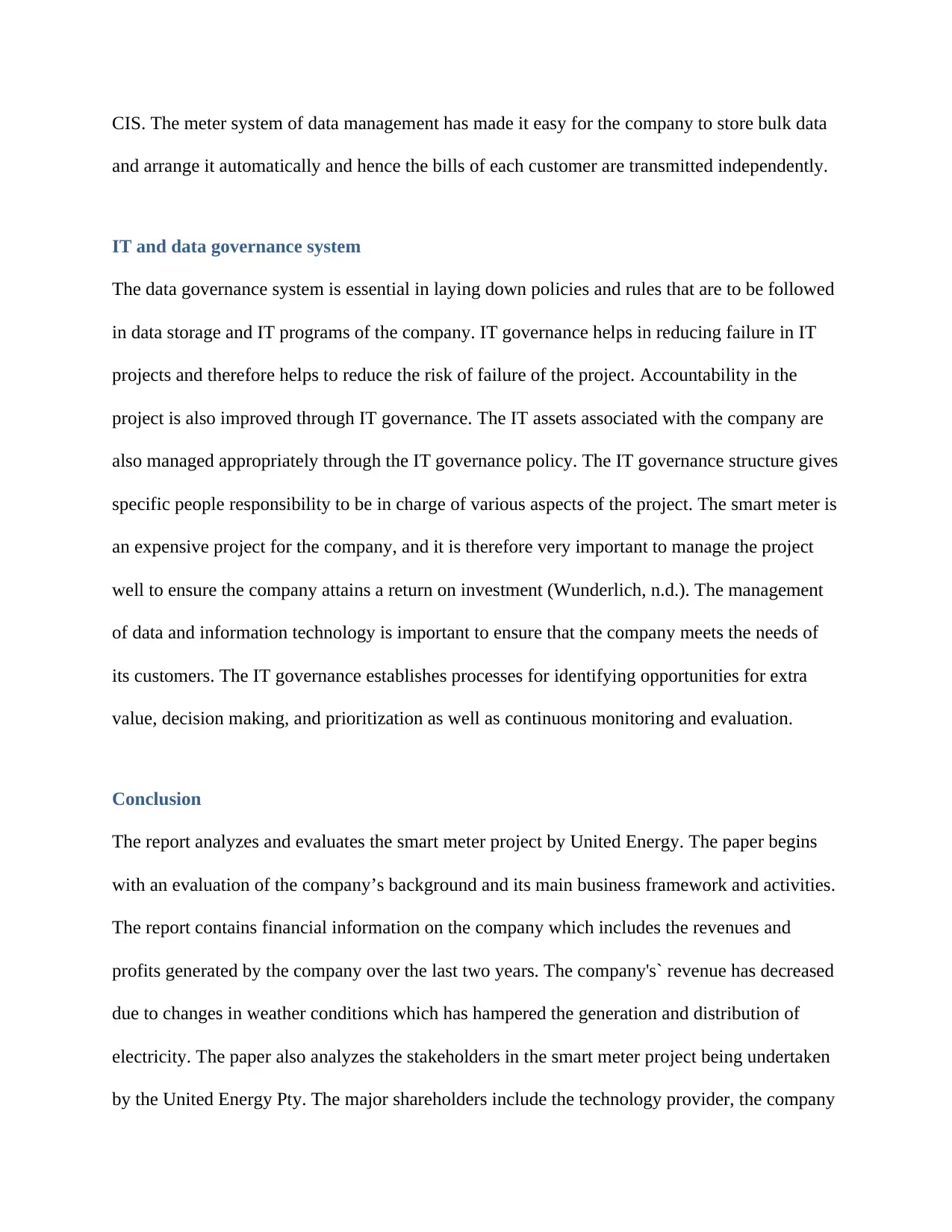
CIS. The meter system of data management has made it easy for the company to store bulk data
and arrange it automatically and hence the bills of each customer are transmitted independently.
IT and data governance system
The data governance system is essential in laying down policies and rules that are to be followed
in data storage and IT programs of the company. IT governance helps in reducing failure in IT
projects and therefore helps to reduce the risk of failure of the project. Accountability in the
project is also improved through IT governance. The IT assets associated with the company are
also managed appropriately through the IT governance policy. The IT governance structure gives
specific people responsibility to be in charge of various aspects of the project. The smart meter is
an expensive project for the company, and it is therefore very important to manage the project
well to ensure the company attains a return on investment (Wunderlich, n.d.). The management
of data and information technology is important to ensure that the company meets the needs of
its customers. The IT governance establishes processes for identifying opportunities for extra
value, decision making, and prioritization as well as continuous monitoring and evaluation.
Conclusion
The report analyzes and evaluates the smart meter project by United Energy. The paper begins
with an evaluation of the company’s background and its main business framework and activities.
The report contains financial information on the company which includes the revenues and
profits generated by the company over the last two years. The company's` revenue has decreased
due to changes in weather conditions which has hampered the generation and distribution of
electricity. The paper also analyzes the stakeholders in the smart meter project being undertaken
by the United Energy Pty. The major shareholders include the technology provider, the company
and arrange it automatically and hence the bills of each customer are transmitted independently.
IT and data governance system
The data governance system is essential in laying down policies and rules that are to be followed
in data storage and IT programs of the company. IT governance helps in reducing failure in IT
projects and therefore helps to reduce the risk of failure of the project. Accountability in the
project is also improved through IT governance. The IT assets associated with the company are
also managed appropriately through the IT governance policy. The IT governance structure gives
specific people responsibility to be in charge of various aspects of the project. The smart meter is
an expensive project for the company, and it is therefore very important to manage the project
well to ensure the company attains a return on investment (Wunderlich, n.d.). The management
of data and information technology is important to ensure that the company meets the needs of
its customers. The IT governance establishes processes for identifying opportunities for extra
value, decision making, and prioritization as well as continuous monitoring and evaluation.
Conclusion
The report analyzes and evaluates the smart meter project by United Energy. The paper begins
with an evaluation of the company’s background and its main business framework and activities.
The report contains financial information on the company which includes the revenues and
profits generated by the company over the last two years. The company's` revenue has decreased
due to changes in weather conditions which has hampered the generation and distribution of
electricity. The paper also analyzes the stakeholders in the smart meter project being undertaken
by the United Energy Pty. The major shareholders include the technology provider, the company
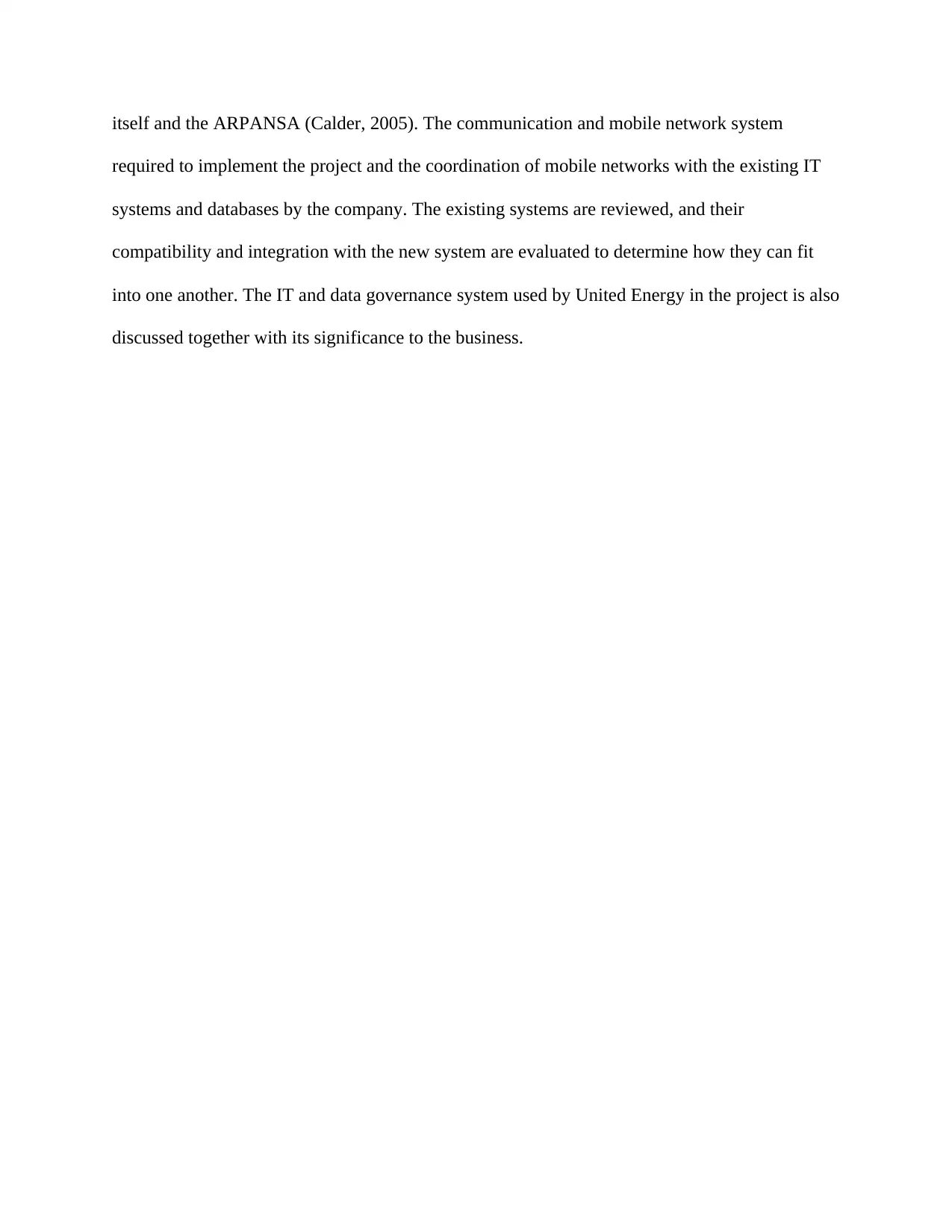
itself and the ARPANSA (Calder, 2005). The communication and mobile network system
required to implement the project and the coordination of mobile networks with the existing IT
systems and databases by the company. The existing systems are reviewed, and their
compatibility and integration with the new system are evaluated to determine how they can fit
into one another. The IT and data governance system used by United Energy in the project is also
discussed together with its significance to the business.
required to implement the project and the coordination of mobile networks with the existing IT
systems and databases by the company. The existing systems are reviewed, and their
compatibility and integration with the new system are evaluated to determine how they can fit
into one another. The IT and data governance system used by United Energy in the project is also
discussed together with its significance to the business.
Secure Best Marks with AI Grader
Need help grading? Try our AI Grader for instant feedback on your assignments.
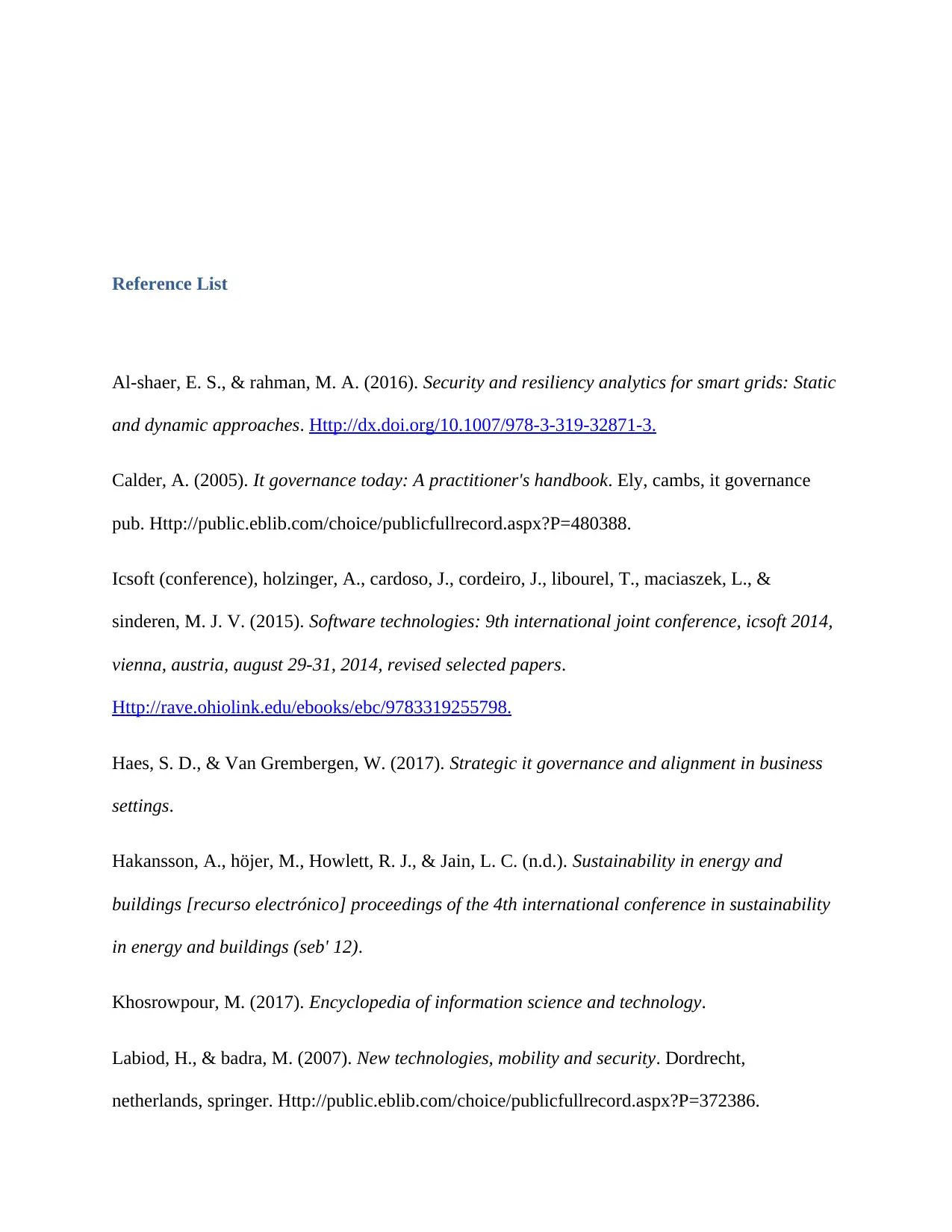
Reference List
Al-shaer, E. S., & rahman, M. A. (2016). Security and resiliency analytics for smart grids: Static
and dynamic approaches. Http://dx.doi.org/10.1007/978-3-319-32871-3.
Calder, A. (2005). It governance today: A practitioner's handbook. Ely, cambs, it governance
pub. Http://public.eblib.com/choice/publicfullrecord.aspx?P=480388.
Icsoft (conference), holzinger, A., cardoso, J., cordeiro, J., libourel, T., maciaszek, L., &
sinderen, M. J. V. (2015). Software technologies: 9th international joint conference, icsoft 2014,
vienna, austria, august 29-31, 2014, revised selected papers.
Http://rave.ohiolink.edu/ebooks/ebc/9783319255798.
Haes, S. D., & Van Grembergen, W. (2017). Strategic it governance and alignment in business
settings.
Hakansson, A., höjer, M., Howlett, R. J., & Jain, L. C. (n.d.). Sustainability in energy and
buildings [recurso electrónico] proceedings of the 4th international conference in sustainability
in energy and buildings (seb' 12).
Khosrowpour, M. (2017). Encyclopedia of information science and technology.
Labiod, H., & badra, M. (2007). New technologies, mobility and security. Dordrecht,
netherlands, springer. Http://public.eblib.com/choice/publicfullrecord.aspx?P=372386.
Al-shaer, E. S., & rahman, M. A. (2016). Security and resiliency analytics for smart grids: Static
and dynamic approaches. Http://dx.doi.org/10.1007/978-3-319-32871-3.
Calder, A. (2005). It governance today: A practitioner's handbook. Ely, cambs, it governance
pub. Http://public.eblib.com/choice/publicfullrecord.aspx?P=480388.
Icsoft (conference), holzinger, A., cardoso, J., cordeiro, J., libourel, T., maciaszek, L., &
sinderen, M. J. V. (2015). Software technologies: 9th international joint conference, icsoft 2014,
vienna, austria, august 29-31, 2014, revised selected papers.
Http://rave.ohiolink.edu/ebooks/ebc/9783319255798.
Haes, S. D., & Van Grembergen, W. (2017). Strategic it governance and alignment in business
settings.
Hakansson, A., höjer, M., Howlett, R. J., & Jain, L. C. (n.d.). Sustainability in energy and
buildings [recurso electrónico] proceedings of the 4th international conference in sustainability
in energy and buildings (seb' 12).
Khosrowpour, M. (2017). Encyclopedia of information science and technology.
Labiod, H., & badra, M. (2007). New technologies, mobility and security. Dordrecht,
netherlands, springer. Http://public.eblib.com/choice/publicfullrecord.aspx?P=372386.
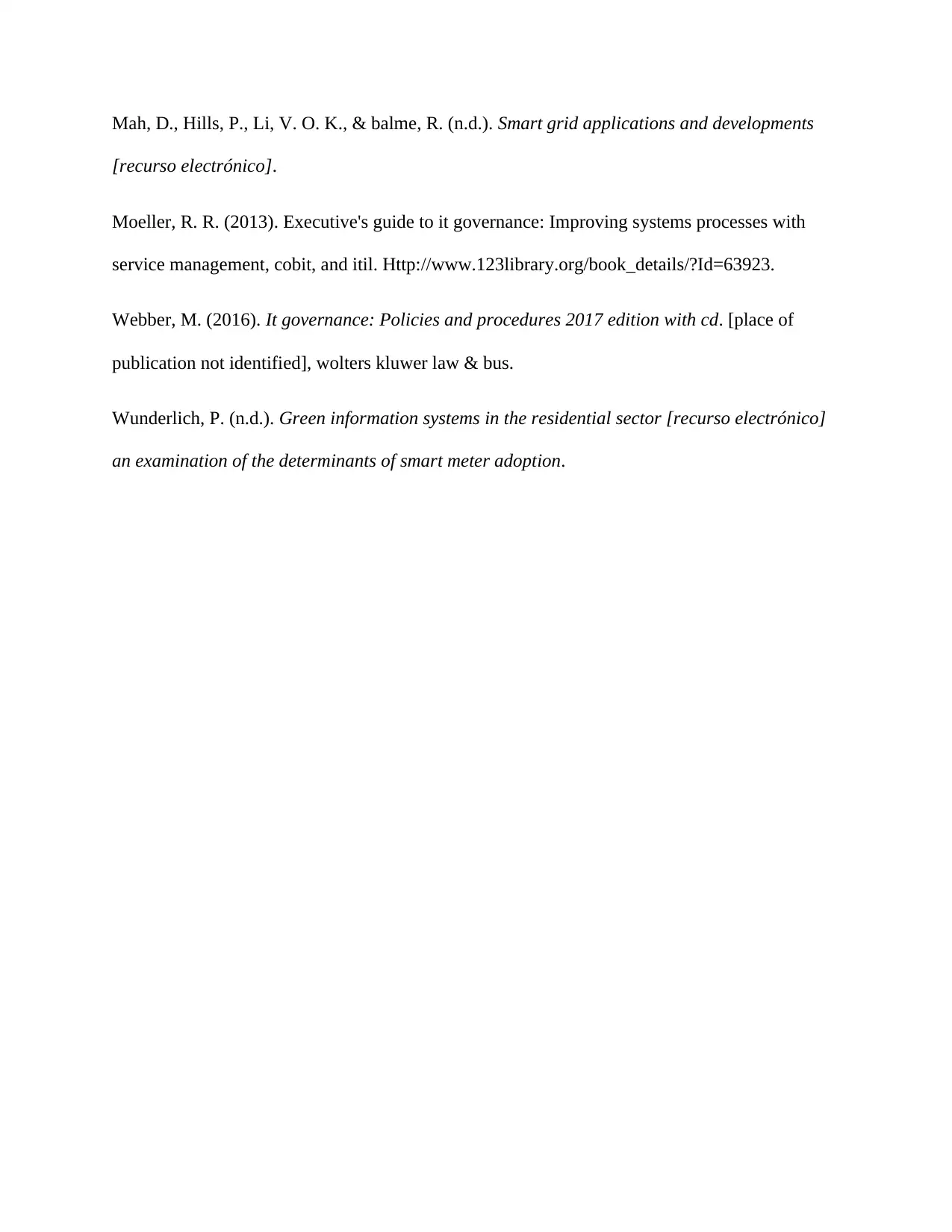
Mah, D., Hills, P., Li, V. O. K., & balme, R. (n.d.). Smart grid applications and developments
[recurso electrónico].
Moeller, R. R. (2013). Executive's guide to it governance: Improving systems processes with
service management, cobit, and itil. Http://www.123library.org/book_details/?Id=63923.
Webber, M. (2016). It governance: Policies and procedures 2017 edition with cd. [place of
publication not identified], wolters kluwer law & bus.
Wunderlich, P. (n.d.). Green information systems in the residential sector [recurso electrónico]
an examination of the determinants of smart meter adoption.
[recurso electrónico].
Moeller, R. R. (2013). Executive's guide to it governance: Improving systems processes with
service management, cobit, and itil. Http://www.123library.org/book_details/?Id=63923.
Webber, M. (2016). It governance: Policies and procedures 2017 edition with cd. [place of
publication not identified], wolters kluwer law & bus.
Wunderlich, P. (n.d.). Green information systems in the residential sector [recurso electrónico]
an examination of the determinants of smart meter adoption.
1 out of 12
Related Documents
Your All-in-One AI-Powered Toolkit for Academic Success.
+13062052269
info@desklib.com
Available 24*7 on WhatsApp / Email
![[object Object]](/_next/static/media/star-bottom.7253800d.svg)
Unlock your academic potential
© 2024 | Zucol Services PVT LTD | All rights reserved.





